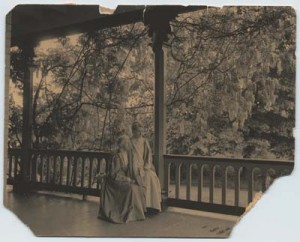 Born March 4, 1856
Born March 4, 1856
Birthplace Peterboro, NY
Died March 1, 1912
Grave Site Peterboro, NY
Contribution Philanthropist and suffragist
Anne Fitzhugh Miller* was born in Peterboro, New York on March 4, 1856. She was the youngest child and only daughter of Charles Dudley Miller and Elizabeth Smith Miller. She had three brothers, Gerrit Smith, Charles Dudley, and William Fitzhugh.
Miller’s father, a member of a well-known Utica family, had been a banker in Cazenovia, New York. Her mother was the daughter of Gerrit Smith, a wealthy reformer, legislator and philanthropist. Elizabeth Smith Miller, a cousin of Elizabeth Cady Stanton and a women’s suffragist in her own right, is known for having designed and worn an early version of the “Bloomer Costume” in the early 1850s.
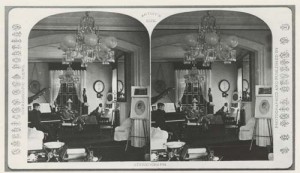 In 1869, when Miller was thirteen years old, her family moved to Lochland, an estate in Geneva (Ontario County), New York. Miller’s grandfather, Gerrit Smith, had been known for providing a pleasing refuge for nineteenth-century thinkers and reformers at his estate in Peterboro. Her mother continued this tradition at Lochland, and it soon became known as a popular stopping place, cherished for its warm hospitality and interesting conversation. Miller not only grew up in this atmosphere; she lived at Lochland for her entire adult life, helping her mother to maintain and uphold its atmosphere of hospitality.
In 1869, when Miller was thirteen years old, her family moved to Lochland, an estate in Geneva (Ontario County), New York. Miller’s grandfather, Gerrit Smith, had been known for providing a pleasing refuge for nineteenth-century thinkers and reformers at his estate in Peterboro. Her mother continued this tradition at Lochland, and it soon became known as a popular stopping place, cherished for its warm hospitality and interesting conversation. Miller not only grew up in this atmosphere; she lived at Lochland for her entire adult life, helping her mother to maintain and uphold its atmosphere of hospitality.
Elizabeth Cady Stanton was a frequent visitor to Lochland. In 1883, she spent six weeks there after returning from Europe. In 1889 she also spent “several” weeks there, along with two of her married daughters. The Millers played host to Stanton and Susan B. Anthony in 1899 for a long visit and subsequently these two famous suffragists spent time at Lochland during the summer months. In 1905, Anthony and her sister Mary visited Lochland for a short time in order to meet up with another guest of the Millers, Captain John Robinson, with whom they had crossed the ocean on more than one occasion.
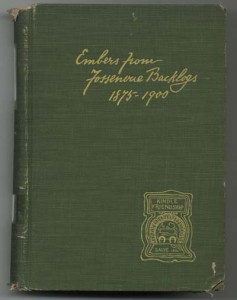 In 1875, Anne Miller extended the family’s tradition of providing a comfortable and stimulating place for thoughtful people when she and a friend, Jane Ver Planck, started Camp Fossenvue on the eastern shore of Seneca Lake. Max Eastman, a well-known reformer who often visited the camp, called it a “point of focus for the highest culture of the time.” In 1900, Miller preserved and distributed memories of the camp in the publication Embers from Fossenvue Backlogs.
In 1875, Anne Miller extended the family’s tradition of providing a comfortable and stimulating place for thoughtful people when she and a friend, Jane Ver Planck, started Camp Fossenvue on the eastern shore of Seneca Lake. Max Eastman, a well-known reformer who often visited the camp, called it a “point of focus for the highest culture of the time.” In 1900, Miller preserved and distributed memories of the camp in the publication Embers from Fossenvue Backlogs.
Anne Miller emerged as a spokesperson for the suffrage cause at the New York State Constitutional Convention, held in 1894. There, she gave a speech advocating women’s suffrage. She attended most state suffrage conventions from that time on until her death, and was regarded as one of Ontario County’s leading suffragists.
The Millers became particularly active as a “mother and daughter team” in local and state suffrage circles after the death of Anne’s father, Charles Dudley Miller, in February of 1896. In 1897, Elizabeth Smith Miller persuaded the New York State Woman’s Suffrage Association to hold its annual convention in Geneva. Many of the delegates stayed at Lochland. Shortly thereafter, Anne Miller was inspired to call for the organization of a political equality club for Geneva. The organizational meeting for the Geneva Political Equality Club (GPEC) was held less than one month after the convention on November 30, 1897 at Geneva’s YMCA (Young Men’s Christian Association). It was attended by fifty people, who became its charter members. Elizabeth Smith Miller was named honorary President. Anne Miller, initially reluctant to take on the office of president, tried to convince others to take this position. Unsuccessful in her attempts, she accepted the presidency of the Club in February of 1899, a position she held until 1911.
Under Miller’s stewardship, Geneva’s Political Equality Club became a thriving organization. In 1904, the New York State Woman’s Suffrage Association proclaimed at its annual convention that during the past year GPEC had acquired the most members of any local club. By 1907, the club had nearly 400 members and was the largest Political Equality Club in the state.
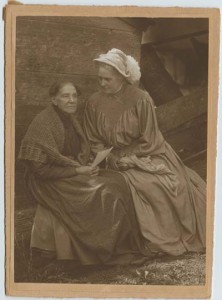 The GPEC charged dues of fifty cents per year and held monthly meetings. Thanks to the political and social connections of the Millers (along with the charms afforded by a stay for speakers at Lochland), the Club managed to attract a wide array of nationally and internationally prominent lecturers for its meetings, including Elizabeth Cady Stanton, Susan B. Anthony, the Reverend Anna Howard Shaw, the radical Pankhursts from England, Lucy Stone, Henry Blackwell, Carrie Chapman Catt, and Charlotte Perkins Gilman. Another attraction which the Millers offered to club members was the “piazza party” held every late Spring at Lochland. These parties, which wrapped up the Club’s yearly activities from 1898 until 1910, were also known for featuring prominent suffrage speakers.
The GPEC charged dues of fifty cents per year and held monthly meetings. Thanks to the political and social connections of the Millers (along with the charms afforded by a stay for speakers at Lochland), the Club managed to attract a wide array of nationally and internationally prominent lecturers for its meetings, including Elizabeth Cady Stanton, Susan B. Anthony, the Reverend Anna Howard Shaw, the radical Pankhursts from England, Lucy Stone, Henry Blackwell, Carrie Chapman Catt, and Charlotte Perkins Gilman. Another attraction which the Millers offered to club members was the “piazza party” held every late Spring at Lochland. These parties, which wrapped up the Club’s yearly activities from 1898 until 1910, were also known for featuring prominent suffrage speakers.
Under Miller’s leadership, the GPEC served as a model for the formation of other local Political Equality Clubs in Ontario County. In 1903, Miller helped to establish the Ontario County Political Equality Association. She acted as president of this association from its inception until 1907.
In 1907, when the New York State Woman’s Suffrage Association again met in Geneva, Elizabeth and Anne Miller hosted a memorial service for Mary S. Anthony, who had passed away earlier that year. Numerous convention delegates attended the service, held on the porch at Lochland.
Miller also held office in the New York State Woman’s Suffrage Association and participated in other statewide and national suffrage activities. In addition to her first public speech on the subject of women’s suffrage at the 1894 constitutional convention, she was present at an 1899 suffrage hearing in the New York Senate Chamber before the State Judiciary Committee. When the New York State legislature held numerous committee hearings during congressional sessions of 1902, 1903, 1904 and 1905, she was often there, a vigorous advocate for giving women taxpayers a vote on issues involving taxation. She also represented New York State at a U.S. Senate hearing regarding the submission of a woman suffrage amendment to the United States Constitution in February of 1906.
The scrapbooks of the GPEC show that Miller also corresponded with numerous politicians. In 1909, she chided Theodore Roosevelt for stating that although he supported women’s suffrage, he did “not regard it as a very important matter.” In 1910, Miller, along with Ella Hawley Crossett, spoke with Governor Charles E. Hughes to try to convince him to submit an amendment favoring women’s suffrage.
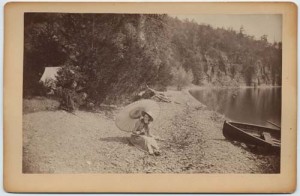 Anne Fitzhugh Miller and her mother were fortunate in having the means to promote their causes financially, and they were known for their philanthropic endeavors on behalf of women’s rights. Shortly after Susan B. Anthony’s death, suffragists started a subscription fund for the cause. By May of 1907, $60,000 had been raised. Elizabeth Smith Miller gave $1,000, and Anne Fitzhugh Miller contributed $500. In 1910, the Millers contributed $300 in support of the State of Washington suffrage amendment. And, shortly after William Smith College of Geneva was founded, Miller gave the institution $2,000 for a permanent endowment, with the instructions that interest from this money be used to pay the tuition of woman students from Geneva.
Anne Fitzhugh Miller and her mother were fortunate in having the means to promote their causes financially, and they were known for their philanthropic endeavors on behalf of women’s rights. Shortly after Susan B. Anthony’s death, suffragists started a subscription fund for the cause. By May of 1907, $60,000 had been raised. Elizabeth Smith Miller gave $1,000, and Anne Fitzhugh Miller contributed $500. In 1910, the Millers contributed $300 in support of the State of Washington suffrage amendment. And, shortly after William Smith College of Geneva was founded, Miller gave the institution $2,000 for a permanent endowment, with the instructions that interest from this money be used to pay the tuition of woman students from Geneva.
In 1910, Miller gradually withdrew from her activities in the GPEC, owing to the ill health of her mother. Elizabeth Smith Miller died in May 1911, and within months Miller seemed ready to resume her public activities. Although she had resigned the presidency of the GPEC, she gave a speech in September, 1911 at the dedication of a public fountain donated to the town by her late mother. Later that same year, she also engaged in suffrage “lobbying” activities, hoping to ensure that Ontario County Assemblyman T.B. Wilson would vote in favor of women’s rights, and held a luncheon at Lochland for this purpose. Along with Wilson, her guests included Harriet May Mills and Harriot Stanton Blatch (the daughter of Elizabeth Cady Stantion), two prominent suffragists.
Early during 1912, Miller left for a long trip to visit New York and Boston. She died in Boston on March 1, 1912. (Last Will and Testament)
*N.B. Miller is referred to as both “Ann” and “Anne.” A biography of her mother, Elizabeth Smith Miller (in Notable American Women) states: “Mrs. Miller’s daughter [Ann] seems to have spelled her name ‘Anne’ in later life.” (NAW II 541)
Bibliography of Suggested Books & Articles
- Barry, Kathleen, Susan B. Anthony: A Biography of a Singular Feminist, New York: New York University press, 1988.
- Emmons, E. Thayles, The Story of Geneva, Geneva, NY: The Geneva Daily Times, 1931; republished Geneva, NY: The Finger Lakes Times, 1982.
- Garraty, John A. And Mark C. Carnes, eds., American National Biography, NY: Oxford University Press, 1999. (from biography of Elizabeth Smith Miller, v. 15, pp. 479-80, written by Wendy Gamber)
- Harper, Ida Husted, The Life and Work of Susan B. Anthony, 3 vols., v. III, Indianapolis, The Hollenbeck Press, 1908, pp. 1399-1401.
- Harper, Ida Husted, History of Woman Suffrage, Susan B. Anthony & National American Woman Suffrage Association, 1902 and 1922, IV, p. 846n, 861, v. V, p. 279, v. VI, p. 443, 454, 457, 682.
- Huff, Robert A., “Anne Miller and the Geneva Political Equality Club, 1897-1912,” New York History, (October 1984).
- James, Edward t., Janet Wilson James and Paul S. Boyer, eds., Notable American Women, 1607-1950, Cambridge, Mass: Belknap Press (Harvard University), 1971. (Biography of Elizabeth Smith Miller, v. 2, pp. 540-41, written by Elizabeth B. Warbasse.)
- Stanton, Elizabeth Cady, Eighty Years and More: Reminiscences 1815-1897, NY: Schocken Books, c1898, 1971, 1973.